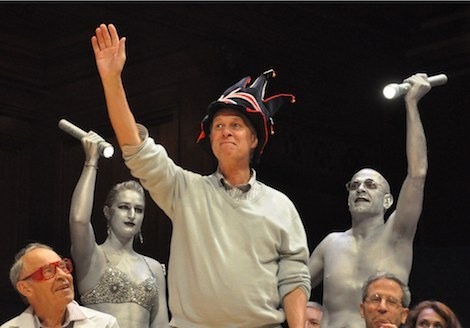Marc Abrahams's Blog, page 515
February 18, 2013
The Lodger Who Watched Them Eat

Mary Douglas, who supervised the man who watched people eat
Confident that no one would notice what he was doing, Michael Nicod spent months in the homes of families he did not know, making detailed notes about everything they ate. Nicod was performing research for Britain’s Department of Health and Social Security in 1974. He and his colleague, University College London professor Mary Douglas, wrote a report called Taking the Biscuit: The Structure of British Meals.
Nicod and Douglas wanted to identify what typical British persons see as the essential parts of their typical meals. The pair drew on their training as anthropologists: “We imagined a dietician in an unknown Papuan or African tribe wondering how to introduce a new, reinforcing element into tribal diet. We assumed that the dietician’s first task would be to discover how the tribe ‘structured’ their food.”
Nicod lived as a lodger with “four working-class families where the head was engaged in unskilled manual labour”, in East Finchley, Durham, Birmingham and Coventry. He stayed in each place at least a month, “watching every mouthful and sharing whenever possible”….
—So begins this month’s Improbable Research column in The Guardian.

February 17, 2013
Dr. Altschuler on … Applied Ice Cream Headaches
 Cluster Headaches are said to affect around 0.1% of the population and are characterised by very intense pain, usually on just one side of the head. The discomfort is so extreme that even the most experienced physicians might struggle to comprehend degree of suffering of the patient – unless, that is, they were also experiencing something very similar. And fortunately, a reliable method for rapidly inducing very intense headaches is readily available – simply by eating very cold ice-cream a bit too quickly. Or, more precisely -
Cluster Headaches are said to affect around 0.1% of the population and are characterised by very intense pain, usually on just one side of the head. The discomfort is so extreme that even the most experienced physicians might struggle to comprehend degree of suffering of the patient – unless, that is, they were also experiencing something very similar. And fortunately, a reliable method for rapidly inducing very intense headaches is readily available – simply by eating very cold ice-cream a bit too quickly. Or, more precisely -
“… [it's] most readily induced by rapidly drinking an ice cold beverage of slush – water/small pieces of ice – consistency immediately after a few bites of a warm, dry cracker.”
The innovative technique is fully described by Eric Altschuler, M.D., Ph.D. (who is currently Associate Professor of Physical Medicine and Rehabilitation, New Jersey Medical School and Associate Professor of Microbiology & Molecular Genetics, New Jersey Medical School) in his article for the journal Medical Hypotheses, 66, 685. Using ice cream headache to help physicians experience the pain of and empathize with cluster headache patients.
“I think that all physicians and physicians-in-training would benefit and should be made to experience the exquisite pain of ice cream headache to help them understand, empathize and appreciate the urgency for sufficient prophylaxis and treatment of the pain of their cluster headache patients.”
QUESTION: Might there be other ailments and diseases which could be better understood by artificially inducing analogous symptoms in the physician? If so, what would be the generic term for this technique? (bearing in mind that the word Homeopathy, meaning ‘similar feeling, suffering, emotion, disorder, disease’ is already taken)
COMING SOON: Dr. Altschuler on … famous character’s ailments

The effect of climate change on great tits
This new study relates two much-discussed topics:
“A model approach to project the start of egg laying of Great Tit (Parus major L.) in response to climate change,” Frank-M. Chmielewski, Klaus Blümel, Carina Scherbaum-Heberer, Bettina Koppmann-Rumpf, Karl-Heinz Schmidt, International Journal of Biometeorology, vol. 57, no. 2, March 2013, pp 287-297.
(Thanks to investigator Tom Gill for bringing this to our attention, and for suggesting the headline.)

February 16, 2013
Bobby McFerrin’s demo: music and expectations
In this video, Bobby McFerrin demonstrates many things, using barely a word:
(HT Vaughn Tan)

February 15, 2013
Come to the Improbable Research show TONIGHT at AAAS Boston
At the AAAS Annual Meeting in Boston, come to the (annual!) Improbable Research show.
Where: Sheraton Boston Hotel (near the Prudential Center), Constitution Ballroom B
When: February 16, 2013, Saturday, 8:00-9:30 pm.
This show is FREE, and open to the general public — but space is limited, so get there a bit early. [TWITTER: #AAASmtg] Featuring:
Marc Abrahams , editor of the Annals of Improbable Research
George Wolford , Ig Nobel Prize winner (brain activity in a dead salmon)
Dr. Deborah Anderson , Ig Nobel Prize winner (effect of Coca-Cola on sperm motility)
Daniel Rosenberg (performing Moments of Science)
Robin Abrahams (letter from the Chinese translator of the first Ig Nobel book)
Corky White (“How I catered a Roman orgy for Harvard Professors”)
Dr. Thomas Michel and soprano Maria Ferrante will perform songs from Ig Nobel Operas
Gus Rancatore (of Toscanini’s Ice Cream, will unveil newly invented, scientifical ice cream flavors)
With the assistance of human spotlights Jim Bredt and Katrina Rosenberg [pictured below], who will illuminate the proceedings
With the assistance of majordomo Gary Dryfoos and minordomos Jenny Gutbezahl, Peaco Todd, et al.
With the assistance of eight-year-old Miss Sweetie Poo, who will keep things moving briskly
Others to be announced or inferred.

This photo shows the Human Spotlights illuminating a person of interest (Nobel laureate Rich Roberts) at the most recent Ig Nobel Prize ceremony. The show at the AAAS meeting will feature many illuminated persons of interest. PHOTO: David Holzman.

Pretty, ugly faces, rapidly
Assault someone—you, for instance—with too many beautiful faces, too rapidly, in a particular way, and things turn ugly, explains this study (and its accompanying video, below):
“Flashed face distortion effect: Grotesque faces from relative spaces“, Jason M Tangen [pictured here, right, at low speed], Sean C Murphy, Matthew B Thompson, Perception, 2011, vol. 40, no. 5, pp. 628–30. The authors write:
“We describe a novel face distortion effect resulting from the fast-paced presentation of eye-aligned faces. When cycling through the faces on a computer screen, each face seems to become a caricature of itself and some faces appear highly deformed, even grotesque. The degree of distortion is greatest for faces that deviate from the others in the set on a particular dimension (eg if a person has a large forehead, it looks particularly large).”
(via David Bradley)
BONUS: A photograph of the face of a different Jason Tangen. This one is a real estate agent: 

Involuntary Hippophagia (5): Papal Bull Taboo Origin?
 Those concerned about Involuntary Hippophagia (the unintended ingestion of a horse, or part thereof ) may be wondering just how far back the UK’s distaste for eating horses, unintentionally or not, might go. Improbable can reveal that the puzzle has certainly been on the table for more than a century.
Those concerned about Involuntary Hippophagia (the unintended ingestion of a horse, or part thereof ) may be wondering just how far back the UK’s distaste for eating horses, unintentionally or not, might go. Improbable can reveal that the puzzle has certainly been on the table for more than a century.
‘Rockingham’ (writing in the Boston Evening Transcript, June 19th, 1909.) asserts that the English ‘tabu’ against eating horses could have a theological origin – in the form of a Papal Bull.
“Horseflesh and its eaters are said to have been declared unclean by Pope Gregory III (731 – 741) evidently to discourage a then-prevalent yearning for the ‘flesh pots of Egypt’.”
Rockingham signs off with an observation which may still have some relevance today.
“The prohibition against horseflesh, like many others governing our daily life, has descended in full practical force to us, though the reason therefor has generally been forgotten ages ago.”

Nadia Anastasia Saif joins LFHCfS
Nadia Anastasia Saif has joined the Luxuriant Flowing Hair Club for Scientists (LFHCfS). She says:
I am a undergraduate at The University of Surrey, which I will graduate from with a degree in Medical Microbiology in June. I have already spent a year working in a lab during my placement year, last year and my current dissertation is to Develop An In Vitro Model of The Chicken Caecum; which if I achieve it, should get me published. I was interviewed for my university to demonstrate biosciences at surrey to prospective students, if you follow the link, me and my luxuriant/flowing hair appear at around 1.40; which should prove my science credentials in a less dry manner than sending in my CV.
Nadia Anastasia Saif, LFHCfS
Undergraduate, medical biology
University of Surrey
Guildford, Surrey, UK


O, octopus, where art thou? (A video)
There are many startling videos of octopuses doing surprising octopus things. This video,by Flora Lichtman for Science Friday, is one of the most very all of that:
(Thanks to investigator Susan Kany for bringing this to our attention.)

February 14, 2013
Robots and humans interact – part 3 of 3
Improbable’s final (previous here) look at the RO-MAN Workshop 2012. – the 21st IEEE International Symposium on Robot and Human Interactive Communication, which was held September 9-13, Paris, France.
Part 3 : Floating-in-the-air ‘bot
 ‘Humanoid’ robots go back a long way, and nowadays there are numerous flying robots in the skies, but there are very few which combine the two, and that could be meaningfully categorised as Flying Humanoid Robots (FHRs). But a team of experimenters from Advanced Telecommunications Research Institute International Kyoto, and the Department of Systems Innovation, Osaka University, Japan, have recently built just such a device – called Angel [pictured at left]
‘Humanoid’ robots go back a long way, and nowadays there are numerous flying robots in the skies, but there are very few which combine the two, and that could be meaningfully categorised as Flying Humanoid Robots (FHRs). But a team of experimenters from Advanced Telecommunications Research Institute International Kyoto, and the Department of Systems Innovation, Osaka University, Japan, have recently built just such a device – called Angel [pictured at left]
Angel was filled with helium, and could (in theory) fly all around its human partner. But the team had predictions regarding its positioning in 3-D space : for example -
“…people will not want a robot to come too close to their heads, as the head is the center for sensing and of great importance. People will also not want a robot above their heads, regardless of how far away it is, as the robot could fall or drop something; the humanoid form may furthermore convey a rude impression if the robot’s feet seem dirty or poised to kick the person.”
Thus the designers incorporated a software-based ‘repulsive field’ to keep it within acceptable ‘proxemic’ zones.
“Results suggested that a FHR should fly near head height when communicating, but not too close to or above a person’s head or near a person’s feet; that rotations can show agreement and playfulness; that a standing posture is associated with neutral impressions; and that velocity and acceleration can show arousal.”
The paper can be read here in full : Designing a Flying Humanoid Robot (FHR): Effects of Flight on Interactive Communication
NOTE: Robotic researchers still have the chance to submit papers for RO-MAN 2013 (which will be held in Gyeongju, Korea from August 26 to 29, 2013) as the deadline has been extended to Feb. 28, 2013.
AN ASIDE : Another, this time purely artistic, representation of a human (August Strindberg) interacting with a lighter-than-air companion. (Helium)

Marc Abrahams's Blog
- Marc Abrahams's profile
- 14 followers



